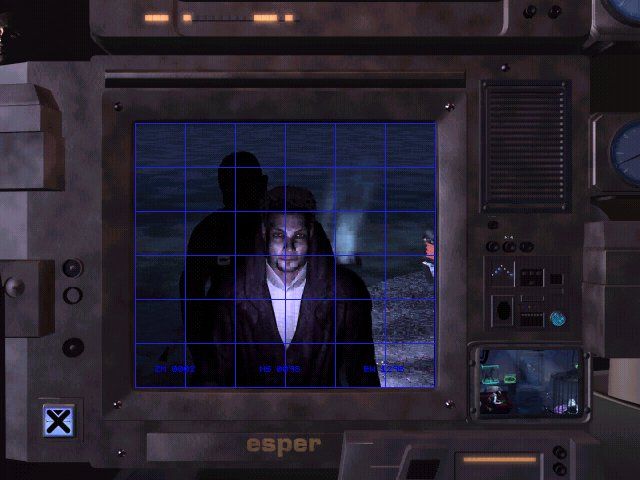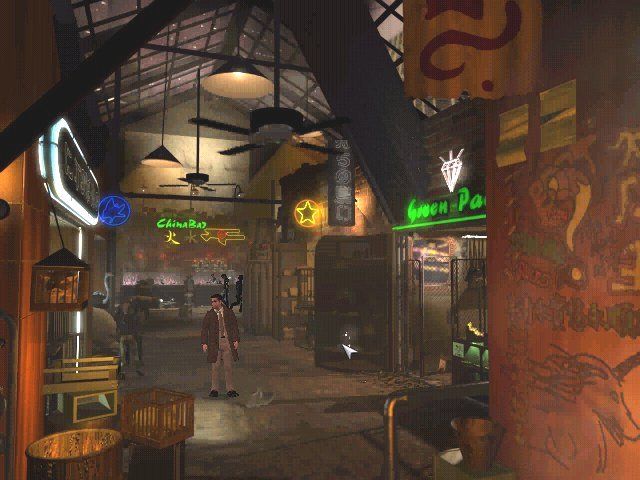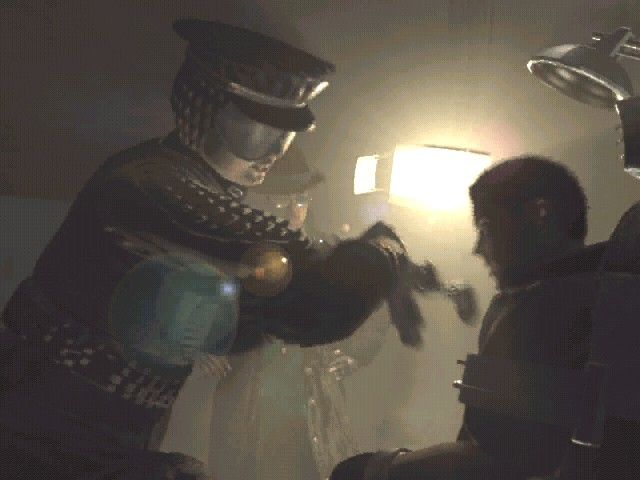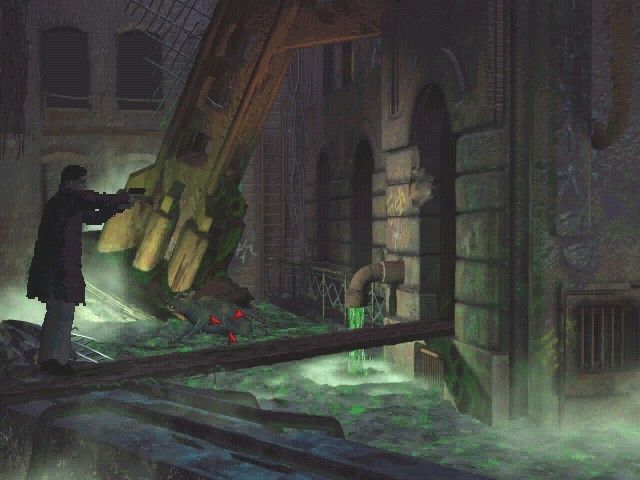Retro Replay Review
Gameplay
Blade Runner’s gameplay revolves around detective work, offering a refreshing departure from traditional puzzle-heavy adventures. Players step into the worn shoes of Ray McCoy, a Blade Runner whose main tools are wit, observation, and a trusty handgun. Rather than solving contrived inventory puzzles, the experience is driven by questioning suspects, cross-referencing forensic evidence, and analyzing environmental clues to unmask replicant renegades. This focus on investigation immerses you in the noir atmosphere, transforming each conversation into a high-stakes dance where a single misstep can send you down a different narrative path.
(HEY YOU!! We hope you enjoy! We try not to run ads. So basically, this is a very expensive hobby running this site. Please consider joining us for updates, forums, and more. Network w/ us to make some cash or friends while retro gaming, and you can win some free retro games for posting. Okay, carry on 👍)
The game’s interface is intuitively designed to handle case files and evidence. You can review photographs, test DNA samples, and examine ballistic data in a dedicated menu, simulating the real procedural workflow of a futuristic police officer. Interactions often require you to select precise dialogue options or present specific proof in order to corner suspects, rewarding diligence and attention to detail. The pacing remains steady throughout, with occasional action sequences—gunfights in dimly lit alleys—that inject bursts of adrenaline without detracting from the investigative core.
One of the most notable features is the branching narrative structure. Your choices—ranging from questioning tactics to life-or-death decisions—directly influence the game’s outcome, leading to one of six possible endings. This not only enhances replayability, but also underscores the weight of every moral dilemma you face. You quickly learn that sparing a replicant’s life or withholding evidence can permanently alter relationships and reveal new story threads on subsequent playthroughs.
Despite its strengths, the gameplay does show its age in a few areas. Movement can feel somewhat clunky, and occasional camera quirks may make navigation in tight corridors frustrating. However, most players find that these minor irritations are easily overlooked once they become engrossed in the investigative process and the compelling choices that drive the story forward.
Graphics
Blade Runner sports some of the most visually striking environments of its era, thanks to meticulously crafted pre-rendered backgrounds. The game’s portrayal of a rain-soaked, neon-lit Los Angeles captures the essence of the film’s dystopian aesthetic. Each city block is dense with atmospheric detail—steam rising from vents, flickering holographic ads, and distant, hazy skyscrapers—all contributing to an immersive sense of place that few contemporaries could rival.
Character models, while polygonal by modern standards, are enhanced by expressive facial animations and mood lighting. NPCs periodically pause in shadow, their silhouettes dancing under streetlamps, or emerge from fog in a manner that heightens tension. The use of dynamic lighting and environmental effects, such as swirling smoke and looming darkness, adds depth to the pre-rendered scenes and underscores the city’s oppressive ambience.
The game also features fully voiced dialogue with performances that strike a balance between film-like gravitas and video-game flair. The voice acting deepens the immersion, breathing life into both human and replicant characters. Although lip-syncing can sometimes be slightly off, the overall impact of the audio-visual presentation remains powerful, making every interrogation and cutscene feel cinematic.
On the technical side, load times between locations are reasonable for its time, and the interface overlays complement the visuals rather than obstruct them. While modern gamers may notice pixelation or lower resolution textures, the artistic direction endures, and the game’s visual style remains a benchmark for how to translate a film’s look into an interactive medium.
Story
Blade Runner weaves an original narrative that stands alongside the film while offering fresh twists. You follow Ray McCoy as he pursues a cadre of replicant fugitives, but the story never feels like a simple retread. Through branching dialogues and multiple investigation paths, you uncover layers of corporate intrigue, philosophical quandaries, and questions of humanity’s essence. The writing deftly balances homage to Philip K. Dick’s themes with new content that keeps even well-versed fans on their toes.
The script excels at depicting the moral gray areas that define the Blade Runner universe. Every suspect encounter challenges you to discern lies from truth, and every decision forces you to grapple with the ethics of “retiring” sentient beings. As McCoy, you gradually learn more about replicant desires and sufferings, prompting you to question societal norms alongside the protagonist. This character-driven arc culminates in emotionally charged moments that resonate long after the credits roll.
Dialogue choices are often tense and meaningful—choosing to press a confession may earn you vital evidence but risk alienating a potential ally, while opting for compassion could open new narrative branches. The nonlinear structure ensures that no two playthroughs are identical, rewarding exploration of alternate lines of inquiry. Six distinct endings mean that your personal journey as McCoy will feel uniquely yours, whether you lean toward justice, mercy, or something in between.
While some plot threads can feel slightly underdeveloped and occasional exposition slows the pace, the core story remains compelling. Its fidelity to the themes of identity and autonomy, combined with inventive twists, makes Blade Runner one of the most narratively ambitious adventure titles of its time.
Overall Experience
Playing Blade Runner is akin to directing your own cinematic detective thriller. The game’s brooding atmosphere, intricate casework, and branching outcomes coalesce into an experience that feels both expansive and personal. From the rain-slicked streets to the tense interrogation rooms, every setting and narrative beat invites you to lose yourself in a morally complex world.
Replay value is exceptionally high. With multiple paths, endings, and character reveals hidden behind specific choices, you’re encouraged to revisit the game and explore alternative strategies. The forensic menu and evidence board serve as tangible reminders of your investigative progress, making each new clue feel earned and significant. Even years after its release, the sense of discovery remains potent.
That said, Blade Runner’s age shows in technical rough edges. Occasional navigation hiccups and dated animations may distract some players, and the absence of modern conveniences—such as a robust hint system—can make certain investigative leaps challenging. However, for those willing to embrace its classic design, the game’s strengths far outweigh these shortcomings.
Ultimately, Blade Runner stands as a pioneering title that marries cinematic storytelling with interactive investigation. It offers a richly textured world, thought-provoking dilemmas, and enough narrative depth to satisfy both film aficionados and adventure gamers. If you’re seeking a detective-driven journey in a dystopian future where your choices truly matter, this game remains a must-play experience.
 Retro Replay Retro Replay gaming reviews, news, emulation, geek stuff and more!
Retro Replay Retro Replay gaming reviews, news, emulation, geek stuff and more!









Reviews
There are no reviews yet.